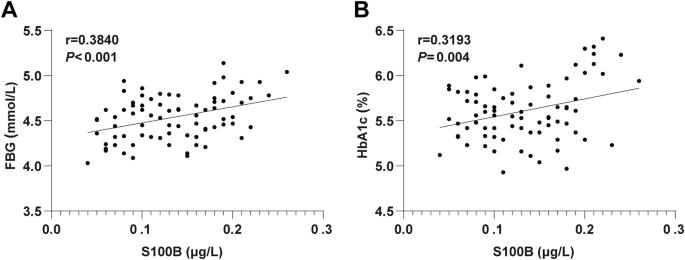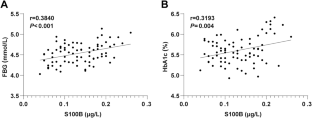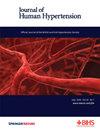血清 S100B 结合糖代谢指标在预测重度子痫前期患者不良妊娠结局中的应用价值
IF 2.7
4区 医学
Q2 PERIPHERAL VASCULAR DISEASE
引用次数: 0
摘要
S100钙结合蛋白B(S100B)和血糖控制可反映母胎风险。我们研究了血清 S100B 结合空腹血糖(FBG)/血红蛋白 A1c(HbA1c)在评估重度子痫前期(SPE)患者妊娠结局中的价值。收集了 SPE 患者/对照组的临床特征。测量FBG/HbA1c和血清S100B水平,并分析其相关性。根据随访结果将 SPE 患者细分为不良/非不良结局组。分析了不同指标在预测妊娠结局方面的价值。与健康对照组相比,SPE 患者的收缩压、舒张压、尿蛋白和体重指数较高,血小板、胎龄和婴儿出生体重较低。FBG 和 HbA1c 与血清 S100B 呈正相关。出现不良预后的 SPE 患者的血清 S100B 和 FBG/HbA1c 水平均有所升高。在评估 SPE 患者的不良妊娠结局时,血清 S100B + FBG/HbA1c 的曲线下面积为 0.8412(灵敏度为 77.05%,特异度为 84.21%),高于单独使用其中一项的结果。血清 S100B 和 FBG/HbA1c 是 SPE 患者不良妊娠结局的独立风险因素。总体而言,SPE 患者的血清 S100B 与 FBG/HbA1c 呈正相关。血清 S100B 和 FBG/HbA1c 是独立的风险因素,它们的组合对预测 SPE 患者的不良妊娠结局具有很高的价值。本文章由计算机程序翻译,如有差异,请以英文原文为准。


Application value of serum S100B combined with glucose metabolism indexes in predicting adverse pregnancy outcomes of patients with severe preeclampsia
S100 calcium-binding protein B (S100B) and glucose control are reflective of maternal-fetal risks. We investigated the value of serum S100B combined with fasting blood glucose (FBG)/hemoglobin A1c (HbA1c) in evaluating the pregnancy outcomes of patients with severe preeclampsia (SPE). The clinical characteristics of SPE patients/controls were collected. FBG/HbA1c and serum S100B levels were measured, with their correlations analyzed. SPE patients were subdivided into adverse/non-adverse outcome groups based on follow-up results. The value of different indexes in predicting pregnancy outcomes was analyzed. SPE patients showed higher systolic blood pressure, diastolic blood pressure, urine protein, and body mass index and lower platelets, gestational age at delivery, and infant birth weight than healthy controls. FBG and HbA1c were positively correlated with serum S100B. SPE patients with adverse outcomes exhibited increased serum S100B and FBG/HbA1c levels. The area under the curve of serum S100B + FBG/HbA1c in evaluating adverse pregnancy outcomes of SPE patients was 0.8412 (77.05% sensitivity/84.21% specificity), higher than either alone. Serum S100B and FBG/HbA1c were independent risk factors for adverse outcomes of SPE patients. Overall, serum S100B positively-correlates with FBG/HbA1c in SPE patients. Serum S100B and FBG/HbA1c are independent risk factors, and their combination has high value on predicting adverse pregnancy outcomes of SPE patients.
求助全文
通过发布文献求助,成功后即可免费获取论文全文。
去求助
来源期刊

Journal of Human Hypertension
医学-外周血管病
CiteScore
5.20
自引率
3.70%
发文量
126
审稿时长
6-12 weeks
期刊介绍:
Journal of Human Hypertension is published monthly and is of interest to health care professionals who deal with hypertension (specialists, internists, primary care physicians) and public health workers. We believe that our patients benefit from robust scientific data that are based on well conducted clinical trials. We also believe that basic sciences are the foundations on which we build our knowledge of clinical conditions and their management. Towards this end, although we are primarily a clinical based journal, we also welcome suitable basic sciences studies that promote our understanding of human hypertension.
The journal aims to perform the dual role of increasing knowledge in the field of high blood pressure as well as improving the standard of care of patients. The editors will consider for publication all suitable papers dealing directly or indirectly with clinical aspects of hypertension, including but not limited to epidemiology, pathophysiology, therapeutics and basic sciences involving human subjects or tissues. We also consider papers from all specialties such as ophthalmology, cardiology, nephrology, obstetrics and stroke medicine that deal with the various aspects of hypertension and its complications.
 求助内容:
求助内容: 应助结果提醒方式:
应助结果提醒方式:


